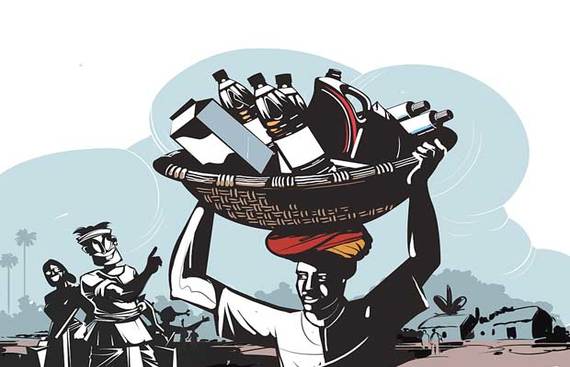Will Rural Market Revive the Businesses?

Few years ago, rural India was all about agriculture and nothing more than that. But, the scenario has totally transformed today, and these areas have turned into a potential demand driver for various industrial giants such as Maruti, Nestle, Dabur, Hero, Marico, and more. The vital reason behind this is that rural India has proved to be more than agriculture.
Saurabh Mukherjea, Founder, Marcellus Investment says, “My suspicion is that the majority of the rural economy is no longer around agriculture and that is allowing them to get a fillip from rising demand for service-oriented work in small-town India.” (Source: ET)
But, how did the rural market undergo rapid transmutation? Firstly, the steadily hovering population number, the rise in population has a direct impact on growing demand. According to the World Bank, India’s rural population accounts for 65.53 percent of the country’s total population as of 2019. Also, certain rural area has witnessed a profitable farming and better marketing as an add-on. Thus, the increased number of villagers has evolved as the potential consumers for the FMCG companies. This hints that better agriculture development results in an improved rural market.
The country’s literacy rate has also increased drastically to 67 percent, over the years. The increased growth in academics in rural India has also contributed to the acceleration of the rural market. Alongside this, the most significant measure of all is the government’s rural development program and other sources that have contributed towards the betterment of the rural segment. Also, the improved infrastructure in a rural area such as transportation, communication, entertainment, and more has backed the rural India development which indeed has drawn the attention of the big giants towards the emerging rural market.
Rural Markets Impact on FMCG
In 2015, the FMCG sector had collapsed and its revenue has dropped from 13 percent a decade back to just four percent, says HDFC Securities reports. But, the sector witnessed a gradual rise over the years. Even during the pandemic, the urban was most affected as compared to the rural areas, thus the number of days of the retail stores dealing with FMCG products which indeed has raised the profit twice in comparison with urban areas throughout the lockdown period.
According to Nielsen’s analysis, the rural area has shown a strong bounce back in FMCG sales in June, but the metro cities are not showing any progress in fact it is sinking. The sales in the rural area and small towns have marked a rise of 12 percent and seven percent respectively. On the other hand, the metros and tier I cities have dropped by four and two percent in June.
Also, the industry experts have pointed out that the COVID-19 induced lockdown sharpened the urban-rural demand pattern of FMCG products. The urban consumers now prefer more of large size product packs, while the rural consumers opt for value packs.
Suresh Narayanan, Chairman and Managing Director, Nestle India says “It is possible that in the semi-urban and probably in some rural market, you would start seeing the smaller packs do better. Also, the number of migrant workers has gone back to the states, they are people who have consumed brands in cities and are aware of its brand, and therefore they might seek these brands out in the rural areas.” (Source: Financial Express)
Opportunities that Rural Market Brings
Presently, the rural market consists of 83.3 crore population, and it estimates to $10 -12 billion opportunity for e-commerce major in the next four years, says EY report, Rural e-commerce: The untapped potential. The report further states that these, in turn, would elevate the household income which would raise the consumption expenditure by diversifying the income source from non-agriculture activities, augmented internet penetration, a growing number of nuclear families in rural India.
Ankur Pahwa, Partner and National Leader – e-Commerce and Consumer Internet, EY India says, “Effective use of vernacular languages and assisted commerce will help drive the large rural online opportunity for e-commerce firms looking to accelerate growth beyond the favorable industry metrics. The key will be to create business models purely with this customer segment at the center of all operations and seamlessly intertwining the physical and digital worlds into a single touchpoint with the rural customers.”
